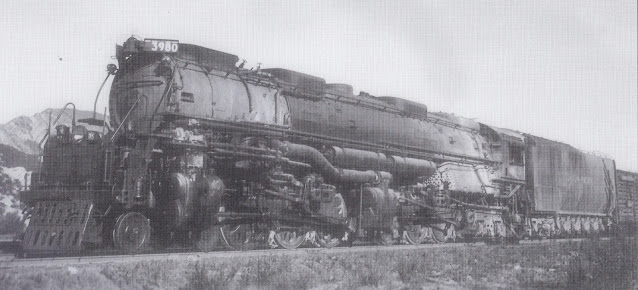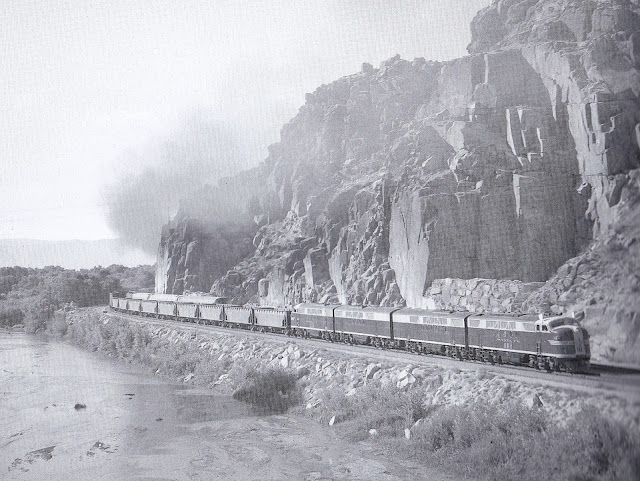We've previously covered Union Pacific's early 4-6-6-4 Challenger steam locos, and now it's time to cover the later, more modern ones. We'll also take a look at some progress in drawing the mainline control panels for the layout's staging deck, and laying down more cork sheets for the yard areas.
The modern Challengers were built during 1942-1944, but those assigned to Cajon Pass were from the #3975-3984 group built in 1943 and converted to fuel oil in 1945.
I'd like to start with a color photo, so I have to use a photo of restored #3985 during an excursion trip in May, 1994. Herb Iske shot a nice photo of the loco coming through the Upper Narrows of Victorville as it began its climb westward on Cajon Pass:
Note that the modern Challengers can be quickly spotted by the low headlight, rather than having one centered on the smokebox as the early Challengers did.
Returning to the late 1940s now, when these locos were sometimes seen on Cajon Pass (not often), here we see #3975 in Los Angeles in Dec. 1945, as shot by G.M. Best:
At least one of these locos got smoke lifters while in Southern California, as seen on #3977 as it descends eastward through Thorn with a train of empties, on its way to Victorville, thanks to Walt Thrall:
Here is #3977 with its smoke lifters in LA in Jan. 1946, as shot by G.M. Best:
Fletcher Swan shot #3978 with a westbound freight at Summit in Feb. 1945:
And here is #3978 with an eastbound freight descending through Lugo in 1948 (perhaps early 1948, as this late date is suspect), thanks to Frank Peterson:
G.M. Best shot #3979 in LA in Dec. 1945:
Here is #3980 with a freight at Cajon in April, 1945, thanks to Walt Thrall:
Finally, here is #3981 running late with the 2nd section of the westbound Pony Express below Cajon in August, 1947, as shot by James Ady:
The word is that #3981 and #3984 alternated on the 2nd section of the Pony Express during 1947, but this train normally crossed Cajon Pass at night, so photos of the locos in this service are rare.
These locos were assigned elsewhere by the end of 1947 or early 1948. And we've never found any photos of the later Challengers in two-tone gray in Southern California.
Now we'll look at a few sample HO models of these locos. I have one of the Athearn Genesis late Challengers, as seen here:
Models were also made by Broadway Limited, as seen here:
Key is one of the brass companies that made a model:
I have an ancient Tenshodo brass model, but it has a coal tender, as seen here:
Let's turn now to whatever layout progress I've made in the last two weeks. Most of the progress was involved with designing more mainline control panels for the lower deck, exchanging many emails with my advisors Tim Fisher and Don Borden.
Don Borden went through several revisions to his CAD drawing of the next mainline panel, which is called the C Tower panel, as some of its tracks lead into the C Yard in staging. Here is the final result, still using Touch Toggles as the buttons for selecting DC cabs and for throwing powered turnouts:
I also had many email exchanges with Tim Fisher about how many blocks should be in the double-ended A Yard. I favored one big block, but he finally convinced me that four blocks would be needed to prevent congestion leading into and out of the yard, with the locos moving to and from their stored trains.


































